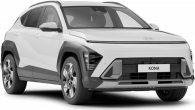Model watch
The CR-V hit the ground running and was one of the first of a new generation of four-wheel drives conceived to suit people who rarely pass the city limits.
Honda's entry was based on its Civic small car, but had a smart looking wagon body that promised performance in the bush, even if it never got that far.
Inside it was comfortable, had a walk through facility to move from the front seats back to sort out troublesome kids, and a 50/50 split-fold rear seat for greater flexibility.
Power from launch was from a 2.0-litre double overhead camshaft fuel-injected four cylinder engine, which produced 94 kW at 5500 rpm. An update in 1999 saw power climb to 108 kW and torque to 182 Nm.
Transmissions on offer were a four-speed manual and four-speed auto.
The CR-V's four-wheel drive system comes into play only when it detects the front wheels are slipping, and it then directs drive to the rear wheels so it's a part-time or on-demand system, but it still has to carry the extra driveline gear which soaks up fuel.
In reality, it's designed to cope with slippery roads, and unsealed bush tracks, as long as you don't head too far off the beaten track.
The Honda's suspension was on the soft side and it would soak up bumps with ease, but it lost out a little on the handling side, wanting to lurch into typical front-wheel drive understeer when pressed in corners.
Power steering was standard, but it had drum rear brakes and ABS wasn't available on the base model.
Honda initially offered the Wagon, which had steel wheels, grey bumpers, standard airconditioning, remote central locking, dual airbags, power windows and mirrors, and an immobiliser. In 1998 it was joined by a 50th Anniversary model, which also had ABS, alloy wheels and a roof rack.
An upgrade in 1999 saw the arrival of the Sport model with standard ABS, alloys, sunroof and picnic tables.
In 2001 there was also a limited edition Sport Classic model which had all of the above and a CD stacker.
In the shop
There isn't much underbody protection on the CR-V, so take a good look underneath for damage to brackets, body panels and suspension components from being driven off-road.
Most will have stayed on the black top, so won't have any visible damage. Walk away from any car that looks as though it has been used extensively off-road and look for one that has been used in town.
It's important to look for a service record. Hondas don't handle poor servicing well, so make sure of regular servicing, preferably by a Honda dealer or specialist.
Hondas are generally sound and well built so give little trouble in service, but listen for knocks and clunks from the suspension while driving,and any grinding noises while turning or braking.
Interior trim generally stands up well in service, but look for the usual wear on seat bolsters from rubbing as people enter and exit the vehicle.
Crunch time
The CR-V rates well in real life crashes. The recent used car survey revealed it performed well above the average. Its unitary body construction and dual front airbags no doubt contribute to its crashworthiness.
Honda CR-V 2005: (4X4) Se
| Engine Type | Inline 4, 2.4L |
|---|---|
| Fuel Type | Unleaded Petrol |
| Fuel Efficiency | 9.5L/100km (combined) |
| Seating | 5 |
| Price From | $3,300 - $5,170 |
Pricing Guides

















.png)











